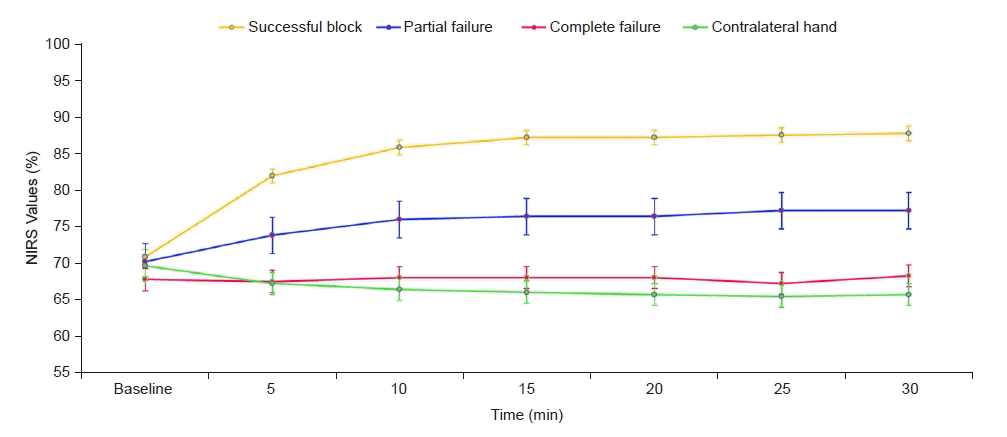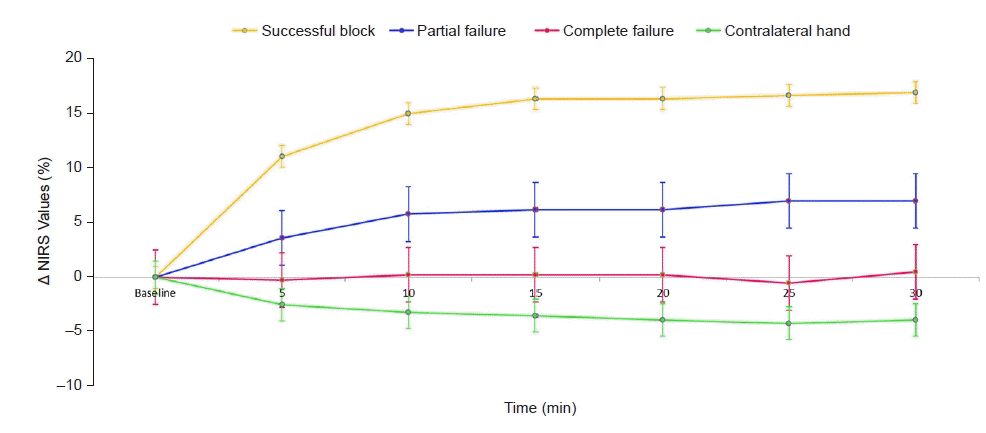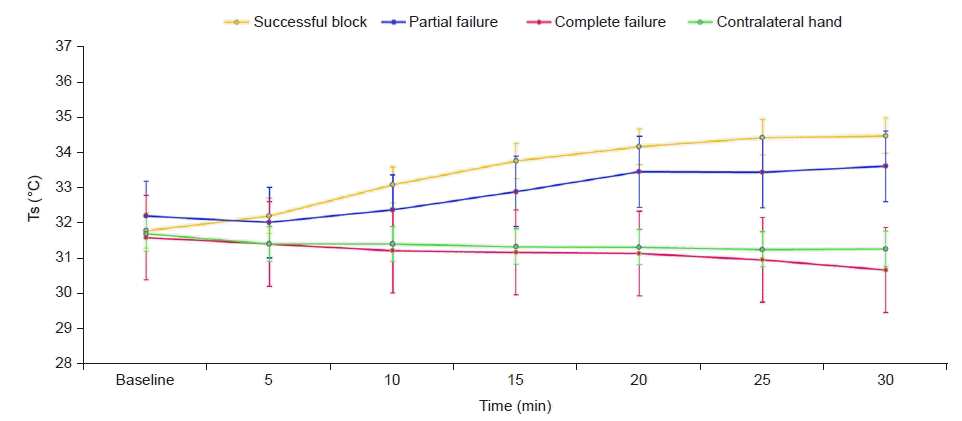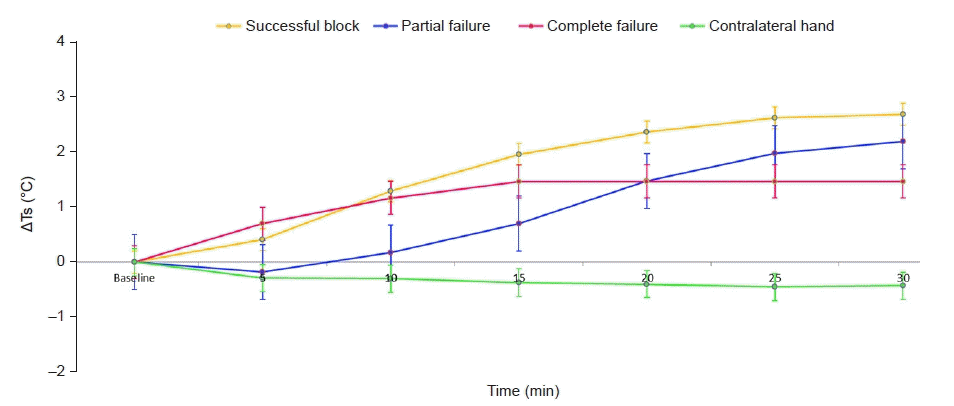1. Sandhu NS, Manne JS, Medabalmi PK, Capan LM. Sonographically guided infraclavicular brachial plexus block in adults: a retrospective analysis of 1146 cases. J Ultrasound Med. 2006; 25:1555–61.
2. Sandhu NS, Capan LM. Ultrasound-guided infraclavicular brachial plexus block. Br J Anaesth. 2002; 89:254–9.

3. Arcand G, Williams SR, Chouinard P, Boudreault D, Harris P, Ruel M, et al. Ultrasound-guided infraclavicular versus supraclavicular block. Anesth Analg. 2005; 101:886–90.

4. Curatolo M, Petersen-Felix S, Arendt-Nielsen L. Assessment of regional analgesia in clinical practice and research. Br Med Bull. 2005; 71:61–76.

5. Paqueron X, Gentili ME, Willer JC, Coriat P, Riou B. Time sequence of sensory changes after upper extremity block: swelling sensation is an early and accurate predictor of success. Anesthesiology. 2004; 101:162–8.
6. Galvin EM, Niehof S, Medina HJ, Zijlstra FJ, van Bommel J, Klein J, et al. Thermographic temperature measurement compared with pinprick and cold sensation in predicting the effectiveness of regional blocks. Anesth Analg. 2006; 102:598–604.

7. Hermanns H, Braun S, Werdehausen R, Werner A, Lipfert P, Stevens MF. Skin temperature after interscalene brachial plexus blockade. Reg Anesth Pain Med. 2007; 32:481–7.

8. Minville V, Gendre A, Hirsch J, Silva S, Bourdet B, Barbero C, et al. The efficacy of skin temperature for block assessment after infraclavicular brachial plexus block. Anesth Analg. 2009; 108:1034–6.

9. Murkin JM, Arango M. Near-infrared spectroscopy as an index of brain and tissue oxygenation. Br J Anaesth. 2009; 103 Suppl 1:i3–13.

10. Desgagnés MC, Lévesque S, Dion N, Nadeau MJ, Coté D, Brassard J, et al. A comparison of a single or triple injection technique for ultrasound-guided infraclavicular block: a prospective randomized controlled study. Anesth Analg. 2009; 109:668–72.

11. Tighe PJ, Elliott CE, Lucas SD, Boezaart AP. Noninvasive tissue oxygen saturation determined by near-infrared spectroscopy following peripheral nerve block. Acta Anaesthesiol Scand. 2011; 55:1239–46.

12. Lange KH, Jansen T, Asghar S, Kristensen PL, Skjønnemand M, Nørgaard P. Skin temperature measured by infrared thermography after specific ultrasound-guided blocking of the musculocutaneous, radial, ulnar, and median nerves in the upper extremity. Br J Anaesth. 2011; 106:887–95.

13. Yarnitsky D, Ochoa JL. Warm and cold specific somatosensory systems. Psychophysical thresholds, reaction times and peripheral conduction velocities. Brain. 1991; 114(Pt 4):1819–26.

14. Fowler CJ, Sitzoglou K, Ali Z, Halonen P. The conduction velocities of peripheral nerve fibres conveying sensations of warming and cooling. J Neurol Neurosurg Psychiatry. 1988; 51:1164–70.

15. Burke D, Mackenzie RA, Skuse NF, Lethlean AK. Cutaneous afferent activity in median and radial nerve fascicles: a microelectrode study. J Neurol Neurosurg Psychiatry. 1975; 38:855–64.

16. Robertson D, Biaggioni I, Burnstock G, Low PA, Paton JFR. Primer on the autonomic nervous system. 3rd ed. San Diego (CA): Academic Press;2012.
17. Asghar S, Lange KHW, Lundstrøm LH. Blinded observer evaluation of distal skin temperature for predicting lateral infraclavicular block success. Anesth Analg 2015; 120: 246-51. Erratum in: Anesth Analg. 2015; 121:577.
18. Asghar S, Bjerregaard LS, Lundstrøm LH, Lund J, Jenstrup MT, Lange KH. Distal infrared thermography and skin temperature after ultrasound-guided interscalene brachial plexus block: a prospective observational study. Eur J Anaesthesiol. 2014; 31:626–34.
19. Okano T, Okuda Y, Kimura Y, Mishio M, Shinohara M, Kitajima T. Use of near-infrared spectroscopy to evaluate stellate ganglion block. Reg Anesth Pain Med. 2001; 26:186.

20. Quaresima V, Ferrari M. More on the use of near-infrared spectroscopy to evaluate stellate ganglion block. Reg Anesth Pain Med. 2002; 27:111–2.

21. Galvin EM, Niehof S, Verbrugge SJ, Maissan I, Jahn A, Klein J, et al. Peripheral flow index is a reliable and early indicator of regional block success. Anesth Analg. 2006; 103:239–43.

22. Kabon B, Fleischmann E, Treschan T, Taguchi A, Kapral S, Kurz A. Thoracic epidural anesthesia increases tissue oxygenation during major abdominal surgery. Anesth Analg. 2003; 97:1812–7.

23. Cui W, Kumar C, Chance B. Experimental study of migration depth for the photons measured at sample surface. Proc SPIE. 1991; 1431:180–91.




 PDF
PDF Citation
Citation Print
Print







 XML Download
XML Download